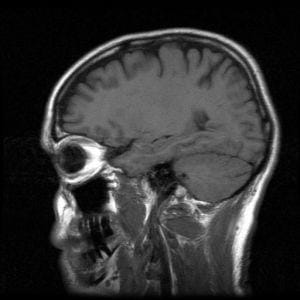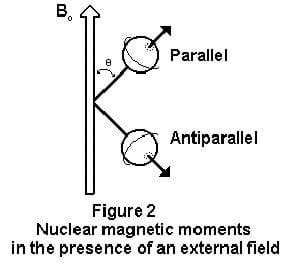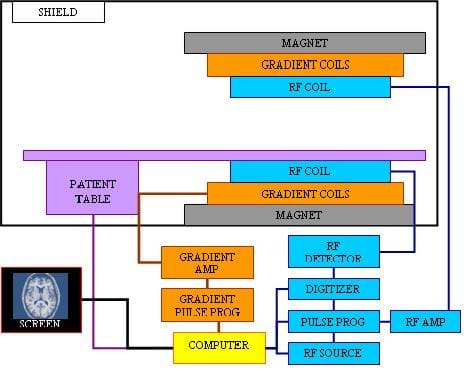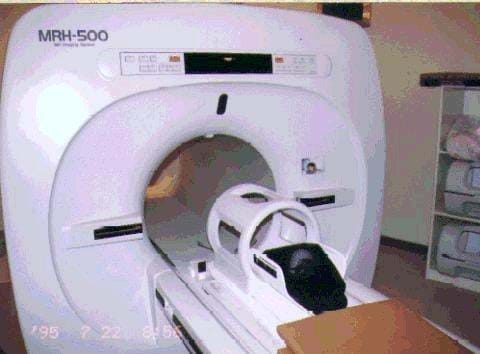Quick Look
Grade Level: 12 (11-12)
Time Required: 15 minutes
Lesson Dependency:
Subject Areas: Physics

Summary
This lesson ties together the preceding lessons of this unit and brings students back to the overarching grand challenge question on MRI safety. During this lesson, students focus on the logistics of magnetic resonance imaging as well as MRI hardware. They integrate this knowledge with their acquired understanding of magnetic fields to create instructional safety awareness pamphlets, websites or slide presentations to solve the challenge question.Engineering Connection
Engineers developed the MRI as a non-invasive imaging method. During this lesson, students think like biomedical engineers to gain an understanding of the purpose of each aspect of the machine. Then students act as safety engineers, combining this information with their knowledge about magnetic fields to determine and communicate safety issues related to the MRI.
Learning Objectives
After this lesson, students should be able to:
- Describe the basics of how magnetic resonance imaging works.
- Describe how the MRI hardware works.
- State and present the connections between an MRI and the magnetic fields studied in this unit.
- Explain safety hazards an MRI machine might present.
Educational Standards
Each TeachEngineering lesson or activity is correlated to one or more K-12 science,
technology, engineering or math (STEM) educational standards.
All 100,000+ K-12 STEM standards covered in TeachEngineering are collected, maintained and packaged by the Achievement Standards Network (ASN),
a project of D2L (www.achievementstandards.org).
In the ASN, standards are hierarchically structured: first by source; e.g., by state; within source by type; e.g., science or mathematics;
within type by subtype, then by grade, etc.
Each TeachEngineering lesson or activity is correlated to one or more K-12 science, technology, engineering or math (STEM) educational standards.
All 100,000+ K-12 STEM standards covered in TeachEngineering are collected, maintained and packaged by the Achievement Standards Network (ASN), a project of D2L (www.achievementstandards.org).
In the ASN, standards are hierarchically structured: first by source; e.g., by state; within source by type; e.g., science or mathematics; within type by subtype, then by grade, etc.
NGSS: Next Generation Science Standards - Science
-
DCI.PS3.A.9-12.3.
At the macroscopic scale, energy manifests itself in multiple ways, such as in motion, sound, light, and thermal energy.
(Grades 9 - 12)
More Details
Do you agree with this alignment?
-
DCI.PS3.C.9-12.1.
When two objects interacting through a field change relative position, the energy stored in the field is changed.
(Grades 9 - 12)
More Details
Do you agree with this alignment?
-
SEP.6.9-12.3.
Communicate technical information or ideas (e.g. about phenomena and/or the process of development and the design and performance of a proposed process or system) in multiple formats (including orally, graphically, textually, and mathematically).
(Grades 9 - 12)
More Details
Do you agree with this alignment?
International Technology and Engineering Educators Association - Technology
-
Medical technologies include prevention and rehabilitation, vaccines and pharmaceuticals, medical and surgical procedures, genetic engineering, and the systems within which health is protected and maintained.
(Grades
9 -
12)
More Details
Do you agree with this alignment?
-
Energy can be grouped into major forms: thermal, radiant, electrical, mechanical, chemical, nuclear, and others.
(Grades
9 -
12)
More Details
Do you agree with this alignment?
State Standards
Tennessee - Science
-
Understand magnetic poles, magnetic fields, and investigate electromagnetic induction.
(Grades
9 -
12)
More Details
Do you agree with this alignment?
Worksheets and Attachments
Visit [www.teachengineering.org/lessons/view/van_mri_lesson_10] to print or download.Introduction/Motivation
Let's refresh our memories about this unit's CHALLENGE QUESTION: A local hospital has just installed a new MRI machine with the capacity to make 3-D images of brains and body parts by placing patients into a strong magnetic field. The hospital wants its staff to understand the risks involved with working near a strong magnetic field and a basic understanding of why those risks occur. Your task is to develop an instructional pamphlet, website or slide presentation explaining the hazards and risks, the physics behind those risks, and recommended safety precautions for staff members to take.
In order to solve the grand challenge and assess MRI safety issues, we must first learn how the MRI machine works. Then we can combine this knowledge with our understanding of magnetic fields to determine the safety issues with the MRI. Safety engineers are always looking for points of weakness in order to eliminate any potential safety hazards so medical equipment is safe for patients and medical staff.
Lesson Background and Concepts for Teachers
Legacy Cycle Information
This lesson is the last lesson in this "legacy cycle" unit. Thus far, students have been presented with information preparing them to solve the challenge question about MRI safety. Lessons 1-9 covered magnetic fields and their properties. In this lesson, students enter the Test Your Mettle phase during which they are challenged to apply the concepts learned to the engineering of an MRI unit, and finally, in the Go Public phase, they are prompted to design a presentation on MRI safety concerns.
Information: Basics of Magnetic Resonance Imaging
Refer to section 5.0 Basic MR Theory in the FDA's MRI Theory Primer for an explanation of the basic functions of MRIs. This explanation applies the concepts students have learned regarding magnetization to the MRI design. You may want to share with students the hazards, safety concerns and reported incidents described in sections 3.0 and 4.0. After a lecture to provide students with the following information, they are ready to Go Public with their challenge question solutions.
Information: MRI Hardware

Hardware Overview: To gain an understanding of the above schematic and exactly how the magnetic field is established, refer to Joseph P. Hornak's hypertext book, The Basics of MRI, specifically paragraphs 2-4 under the Hardware Overview section in Chapter 9: Imaging Hardware at http://www.cis.rit.edu/htbooks/mri/inside.htm.
Magnet: Refer to a clear description of the magnet in Hornak's Chapter 9: Imaging Hardware > Magnet (paragraphs 1 and 2), including many images (click icons to reveal associated images). Hornak's book also provides a glossary of terms.

Gradient Coils: In the next section of Chapter 9, Gradient Coils, three paragraphs describe the gradient coils, which work together carrying opposing current to establish the magnetic field gradient.
RF Coils: The next section of Chapter 9, RF Coils, provides a description of RF coils, which are are responsible for the rotation of the magnetic field.
Assessment
Unit Summary
Grand Challenge Project: Give students the Grand Challenge Project Handout, which states the challenge and suggests three possible ways for them to "go public" by creating presentations relating back to the initial challenge problem on MRI safety: design an instructional safety pamphlet for hospital staff, design a website for hospital employees to get information, make a slide presentation for hospital trainers to use to inform hospital staff. Presentations must cover safety issues and the pertinent scientific concepts relating to magnetostatics and electromagnetism. Refer to the Go Public Grading Rubric for suggested grading criteria.
- Challenge: A nearby hospital has just installed a new magnetic resonance imaging facility that has the capacity to make three-dimensional images of brains and other body parts by putting patients into a strong magnetic field. The hospital wants its staff to have a clear understanding of the risks involved with working near a strong magnetic field and a basic understanding of why those risks occur. Your task is to develop a presentation or pamphlet explaining the risks involved, the physics behind those risks, and recommended safety precautions for all staff members to take.
Additional Multimedia Support
The FDA's eight-page A Primer on Medical Device Interactions with Magnetic Resonance Imaging Systems, is available at http://www.cognitiveneuro.org/SafetyReadings/FDAExternalDeviceGuidance%201997.pdf.
Hornak, Joseph P. “Chapter 9: Imaging Hardware” in The Basics of MRI (a hypertext book). http://www.cis.rit.edu/htbooks/mri/ and http://www.cis.rit.edu/htbooks/mri/chap-9/chap-9.htm.
Subscribe
Get the inside scoop on all things TeachEngineering such as new site features, curriculum updates, video releases, and more by signing up for our newsletter!References
Hayes, C. E., W. A. Edelstein, and J. F. Schenck. "Radio Frequency Resonators." Magnetic Resonance Imaging, ed. by C. L. Partain, R. R. Price, J. A. Patton, M. V. Kulkarni, A. E. Philadelphia, PA: James Saunders, 1988.
Hornack, Joseph P. The Basics of MRI. Henietta, NY: Interactive Learning Software, 1996-2007. Accessed July 27, 2007. http://www.cis.rit.edu/htbooks/mri/
Morrow, G. "Progress in MRI Magnets." Intermagnetics General Corporation, Latham, NY, USA http://www.igc.com/mbg/rd/Mt16paper1Color.pdf
Thomas, S. R., L. J. Busse, and J. F. Schenck. "Gradient Coil Technology." Magnetic Resonance Imaging, ed. by C. L. Partain, R. R. Price, J. A. Patton, M. V. Kulkarni, A. E. Philadelphia, PA: JamesSaunders, 1988.
"A Primer on Medical Device Interactions with Magnetic Resonance Imaging Systems." February 7, 1997. CDRH Magnetic Resonance Working Group, Center for Devices and Radiological Health. U.S. Food and Drug Administration. http://www.fda.gov/cdrh/ode/primerf6.html. Accessed July 27, 2007. http://www.fda.gov/MedicalDevices/DeviceRegulationandGuidance/GuidanceDocuments/ucm107721.htm (The latter document was withdrawn on April 27, 2015. As alternative, see draft at http://www.cognitiveneuro.org/SafetyReadings/FDAExternalDeviceGuidance%201997.pdf)
Copyright
© 2013 by Regents of the University of Colorado; original © 2006 Vanderbilt UniversityContributors
Eric AppeltSupporting Program
VU Bioengineering RET Program, School of Engineering, Vanderbilt UniversityAcknowledgements
The contents of this digital library curriculum were developed under National Science Foundation RET grants no. 0338092 and 0742871. However, these contents do not necessarily represent the policies of the NSF, and you should not assume endorsement by the federal government.
Last modified: May 10, 2022






User Comments & Tips